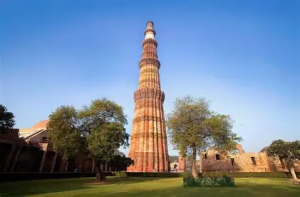Qutub Minar: Delhi’s Towering Relic Stands Firm Amid History and Controversy

Qutub Minar: Delhi’s Towering Relic Stands Firm Amid History and Controversy
As the Qutub Minar pierces Delhi’s skyline at 72.5 meters, the 826-year-old monument remains a striking symbol of India’s layered past, blending Turkic ambition with local craftsmanship. Erected in 1199 by Qutb-ud-din Aibak, the first ruler of the Delhi Sultanate, this UNESCO World Heritage Site has endured invasions, natural calamities, and modern disputes, standing as both a historical marvel and a focal point of cultural debate.
The Qutub Minar’s origins lie in the establishment of Muslim rule in northern India. Commissioned by Aibak, a former slave-turned-general under Muhammad of Ghor, the minar was intended as a victory tower to celebrate the defeat of the last Hindu ruler of Delhi, Prithviraj Chauhan, in 1192. Its construction began in 1199, though Aibak completed only the first storey before his death in 1210. His successor, Iltutmish, expanded the tower, and by 1368, Firoz Shah Tughlaq added the final two storeys, bringing it to its current five-tiered form. Built from red sandstone and marble, the minar’s tapered design, with a base diameter of 14.3 meters narrowing to 2.7 meters at the top, showcases Indo-Islamic architecture, blending Afghan and Persian influences with Indian motifs like lotus borders and bell patterns.
The minar’s purpose remains a subject of scholarly debate. While some historians view it as a victory monument, others argue it served as a minaret for the adjacent Quwwat-ul-Islam Mosque, used to call the faithful to prayer. Its intricate carvings, including Quranic inscriptions and geometric patterns, reflect the cultural synthesis of the era, with materials repurposed from 27 Hindu and Jain temples demolished during Aibak’s conquests—a fact that fuels contemporary disputes over its legacy.
Over centuries, the Qutub Minar has weathered significant challenges. Lightning strikes in 1368 and 1503 damaged its upper sections, prompting repairs by Firoz Shah Tughlaq and later Sikandar Lodi. Earthquakes, including a major one in 1803, further tested its resilience, leading to restoration under British rule in the 19th century. The Archaeological Survey of India (ASI), which has managed the site since India’s independence, has faced ongoing preservation challenges. In 2024, the ASI completed a three-year conservation project to reinforce the minar’s foundation, addressing cracks caused by Delhi’s seismic activity and pollution. The effort, costing ₹15 crore, stirred debate over the use of modern reinforcement techniques, with heritage experts advocating for traditional methods to maintain authenticity.
The Qutub Minar complex, encompassing the Alai Darwaza, Iron Pillar, and Quwwat-ul-Islam Mosque, draws over 3 million visitors annually, making it one of India’s top heritage sites. Its UNESCO designation in 1993 underscores its global significance, yet it remains a lightning rod for socio-political tensions. In 2022, petitions filed in Delhi courts sought to restore Hindu worship at the site, citing its temple-derived materials, sparking protests and counter-claims from Muslim groups emphasizing its Islamic heritage. The ASI, maintaining its secular stewardship, rejected these demands in 2023, citing legal protections under the Places of Worship Act, 1991. The issue resurfaced in early 2025 during a political rally, where a leader’s call to “reclaim” the site reignited online debates, though community leaders across faiths urged restraint to preserve its shared heritage.
Modern challenges also include urban pressures. Encroaching construction and air pollution from Delhi’s traffic have raised concerns about long-term damage, prompting the ASI to propose a buffer zone in 2025, still under review by the Delhi government. Meanwhile, the monument’s role as a tourist hub thrives, with night illumination introduced in 2024 enhancing its appeal, though locals have criticized inadequate crowd management during peak seasons like Diwali and Eid.
As the Qutub Minar approaches its 826th anniversary, it stands as a testament to Delhi’s evolution from a medieval stronghold to a modern metropolis. Its towering presence reflects not just architectural ingenuity but also India’s complex negotiation of history, identity, and preservation. With ongoing efforts to balance tourism with conservation, the minar’s future hinges on safeguarding its physical and cultural integrity amid a rapidly changing capital.
also read : Tesla’s Stock Rollercoaster: Why Elon’s Moves Keep Investors Guessing
Last Updated on: Friday, October 3, 2025 3:28 pm by The Statesman India Team | Published by: The Statesman India Team on Friday, October 3, 2025 3:28 pm | News Categories: News
About Us: The Statesman India covers the latest News on Current News, Business, Sports, Tech, Entertainment, Lifestyle, Automobiles, and more, led by Editor-in-Chief Ankur Srivastava. Stay connected on Facebook, Instagram, LinkedIn, X (formerly Twitter), Google News, and Whatsapp Channel.
Disclaimer: At The Statesman India, we are committed to providing accurate, reliable, and thoroughly verified information, sourced from trusted media outlets. For more details, please visit our About, Disclaimer, Terms & Conditions, and Privacy Policy. If you have any questions, feedback, or concerns, feel free to contact us through email.
Contact Us: newssites1234@gmail.com





